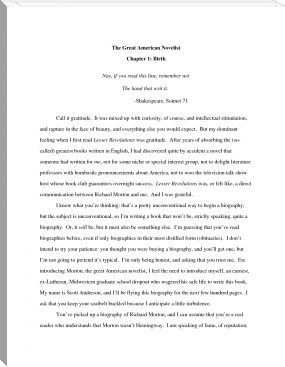The Ocean and Its Wonders by R. M. Ballantyne (free novel reading sites .TXT) 📖

- Author: R. M. Ballantyne
Book online «The Ocean and Its Wonders by R. M. Ballantyne (free novel reading sites .TXT) 📖». Author R. M. Ballantyne
It might be supposed that in such a climate animal life could scarcely exist; but such is not the case. The inhabitants of part of the arctic regions, named Esquimaux (more correctly Eskimos, with the accent on the last syllable), are a stout, hardy, healthy race and the polar bears, foxes, wolves, seals, musk-oxen, walruses, etcetera, that dwell there, seem to enjoy their existence just as much as do the animals of more favoured and warmer climes.
During the short but hot summer of the arctic regions, the immense masses of ice formed in winter are by no means cleared away. A great part of the heat of early summer (there is no season there that merits the name of spring) is spent in breaking up the solid crust of ice on the sea, a large proportion of which is carried south by the currents that flow to the equator, and melted long before they reach the temperate zones. But a considerable quantity of broken ice-masses get locked in narrow places or stranded on shallows; and although they undergo the process of melting the whole summer, they are not much diminished ere the returning frost stops the process and locks them in the new ice of a succeeding winter.
Thus there is no period of the year in which large quantities of ice may not be seen floating about in the arctic seas.
This fact it is that enables us to speak appropriately of the scenery of the Arctic Ocean. And assuredly this scenery of the ice is exceedingly and strikingly beautiful. The imagination cannot conceive the dazzling effect of a bright summer day in those regions, when the ocean is clear as glass, and ice-humps and ice-mountains of every shape and size are glittering in the sun’s rays with intense brilliancy, while the delicate whiteness of these floating islands, and the magical atmospheric illusions by which they are frequently surrounded, render the scene pre-eminently fairy-like.
All the navigators who have penetrated into the arctic seas speak with enthusiasm of the splendour of floating ice-masses. They take the most curious and fantastic shapes; sometimes appearing like great cities of white marble, with domes and towers and spires in profusion; sometimes looming huge and grand like fortresses, and many of them with their summits overhanging so much as to suggest the idea that they are about to fall. This indeed, they often do, adding to the grandeur of the scene, and not a little to the danger, should ships chance to be in the neighbourhood.
The atmospheric illusions, before mentioned, are the result of different temperatures existing within a few miles of each other, and which are caused by the presence of large bodies of ice. The effect of this is to cause the ice-masses on the horizon to appear as if floating in the air, and to distort them into all sorts of shapes, even turning them upside down, and thus affording to an innovative mind a most ample and attractive field wherein to expatiate.
To ascertain the causes of facts and effects so curious must be interesting to all who have inquiring minds. We will, therefore, attempt to describe and account for arctic phenomena in the following chapters as simply as may be.
It is well known that when fresh water becomes so cold that its temperature is 32 degrees of Fahrenheit’s scale, it loses its liquid form and becomes ice. A somewhat lower temperature than this is necessary to freeze salt water; the reason being, that greater force is required to expel the salt which the sea holds in solution,—which salt is always more or less expelled in the process of freezing.
Ice commences to form in the shape of needles, which shoot out at angles from each other. In smooth water, under the influence of intense cold, the process is rapid, and a thin cake soon covers the water, and increases in thickness hour by hour. But when the sea is agitated the process is retarded, and the fine needles are broken up into what arctic navigators call sludge. This, however, soon begins to cake, and is broken by the swell into small cakes; which, as they thicken, again unite, and are again broken up into larger masses. These masses, by rubbing against each other, have their edges slightly rounded up, and in this form receive the name of pancake ice.
When a quantity of ice covers the ocean in a wide level sheet of considerable extent, it is called an ice-field. Fields of this kind are often seen by navigators hundreds of miles in extent, and nearly thirty feet thick. Ice of such thickness, however, only shows five or six feet above water. When fields are broken by heavy ocean-swells, the edges are violently forced up, and fall in débris on the surface; thus hummocks or mounds are formed.
When field-ice breaks up under the influence of an ocean-swell, caused by a storm, the results are terrific.
An exceedingly graphic account of an incident of this kind is given by Dr Brown, in his “History of the Propagation of Christianity.” He writes:—
“The missionaries met a sledge with Esquimaux, turning in from the sea, who threw out some hints that it might be as well for them to return. After some time, their own Esquimaux hinted that there was a ground-swell under the ice. It was then scarcely perceptible, except on lying down and applying the ear close to the ice, when a hollow, disagreeable, grating sound was heard ascending from the abyss. As the motion of the sea under the ice had grown more perceptible, they became alarmed, and began to think it prudent to keep close to the shore. The ice also had fissures in many places, some of which formed chasms of one or two feet; but as these are not uncommon in ice even in its best state, and the dogs easily leap over them, they are frightful only to strangers.
“As the wind rose to a storm, the swell had now increased so much that its effects on the ice were extraordinary, and really alarming. The sledges, instead of gliding smoothly along as on an even surface, sometimes ran with violence after the dogs, and sometimes seemed with difficulty to ascend a rising hill. Noises, too, like the report of cannon, were now distinctly heard in many directions, from the bursting of the ice at a distance. Alarmed at these frightful phenomena, our travellers drove with all haste towards the shore; and, as they approached it, the prospect before them was tremendous. The ice having burst loose from the rocks, was tossed to and fro, and broken in a thousand pieces against the precipices with a dreadful noise; which, added to the raging of the sea, the roaring of the wind, and the driving of the snow, so overpowered them as almost completely to deprive them of the use of their eyes and ears.
“To make the land was now the only resource that remained, but it was with the utmost difficulty that the frightened dogs could be driven forward; and as the whole body of the ice frequently sank below the summits of the rocks, and then rose above them, the only time for landing was the moment it gained the level of the coast—a circumstance which rendered the attempt extremely nice and hazardous.
“Both sledges, however, succeeded in gaining the shore, and were drawn up off the beach, though not without great difficulty. Scarcely had they reached it, when that part of the ice from which they had just escaped burst asunder, and the water, rushing up from beneath, instantly precipitated it into the ocean. In a moment, as if by a signal, the whole mass of ice for several miles along the coast, and extending as far as the eye could reach, began to break up, and to be overwhelmed by the waves. The spectacle was awfully grand. The immense fields of ice rising out of the ocean clashing against each other, and then plunging into the deep with a violence which no language can describe, and with a noise like the discharge of a thousand cannon, was a sight which must have filled the most unreflecting mind with feelings of solemnity.
“The Brethren were overwhelmed with amazement at their miraculous escape, and even the Esquimaux expressed gratitude to God for their deliverance.”
Such is the terrible aspect in which field-ice is seen when broken up and converted into smaller masses or floes. When these lie closely together the mass is called pack-ice; in which shape it usually drifts away with the southern currents, and, separating as it travels south, is met with in loose floating masses, of every fantastic form. There is always, as we have said, a large quantity of floe and pack-ice in the polar seas, which becomes incorporated with the new ice of the succeeding winter; and not infrequently whale and discovery ships get frozen into the pack, and remain there as firmly embedded as if they lay high and dry on land. When the pack is thus re-frozen, it usually remains stationary; but there are occasions and circumstances in which the entire body of a pack drifts slowly southward even during the whole year; showing clearly that oceanic circulation is by no means arrested by the icy hand of the hyperborean winter.
A very remarkable drift of this kind is recorded by Captain McClintock of the Fox, which is worthy of being noticed here, as illustrative of the subject we are now considering and also as showing in a remarkable manner the awful dangers to which navigators may be exposed by the disruption of the pack in spring, and the wonderful, almost miraculous, manner in which they are delivered from imminent destruction.
In attempting to cross Baffin’s Bay, by penetrating what is called the “middle ice,” the Fox was beset, and finally frozen in for the winter; and here, although their voyage may be said to have just commenced, they were destined to spend many months in helpless inactivity and comparative peril and privation. Their little vessel lay in the centre of a field of ice of immense extent; so large, indeed, that they could not venture to undertake a journey to ascertain its limits. Yet this field slowly and steadily descended Baffin’s Bay during the whole winter, and passed over no fewer than 1385 statute miles in the space of 242 days, during which period the Fox was firmly embedded in it!
It is with difficulty the mind can form any adequate conception of the position of those voyagers;—unable to move from their icy bed, yet constantly drifting over miles and miles of ocean; uncertain as to the where or the when of their deliverance from the pack; exposed to the terrible dangers of disrupting ice, and surrounded by the depressing gloom of the long arctic night.
At length deliverance came; but it came surrounded by terrors. In February, McClintock writes thus: “Daylight reveals to us evidences of vast ice-movements having taken place during the dark months, when we fancied all was still and quiet; and we now see how greatly we have been favoured, what innumerable chances of destruction we have unconsciously escaped. A few days ago, the ice suddenly cracked within ten yards
 Have you ever thought about what fiction is? Probably, such a question may seem surprising: and so everything is clear. Every person throughout his life has to repeatedly create the works he needs for specific purposes - statements, autobiographies, dictations - using not gypsum or clay, not musical notes, not paints, but just a word. At the same time, almost every person will be very surprised if he is told that he thereby created a work of fiction, which is very different from visual art, music and sculpture making. However, everyone understands that a student's essay or dictation is fundamentally different from novels, short stories, news that are created by professional writers. In the works of professionals there is the most important difference - excogitation. But, oddly enough, in a school literature course, you don’t realize the full power of fiction. So using our website in your free time discover fiction for yourself.
Have you ever thought about what fiction is? Probably, such a question may seem surprising: and so everything is clear. Every person throughout his life has to repeatedly create the works he needs for specific purposes - statements, autobiographies, dictations - using not gypsum or clay, not musical notes, not paints, but just a word. At the same time, almost every person will be very surprised if he is told that he thereby created a work of fiction, which is very different from visual art, music and sculpture making. However, everyone understands that a student's essay or dictation is fundamentally different from novels, short stories, news that are created by professional writers. In the works of professionals there is the most important difference - excogitation. But, oddly enough, in a school literature course, you don’t realize the full power of fiction. So using our website in your free time discover fiction for yourself. 




Comments (0)